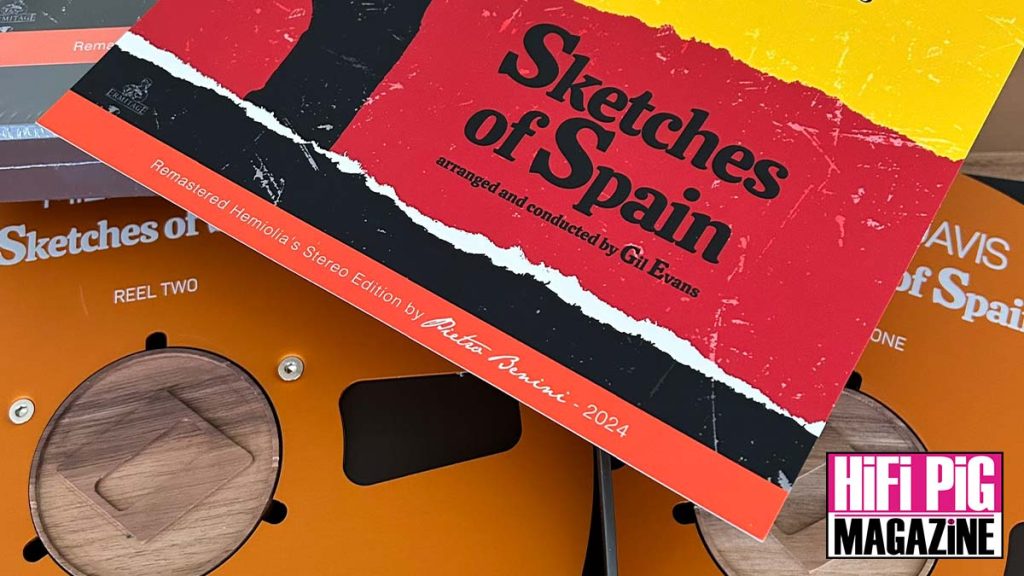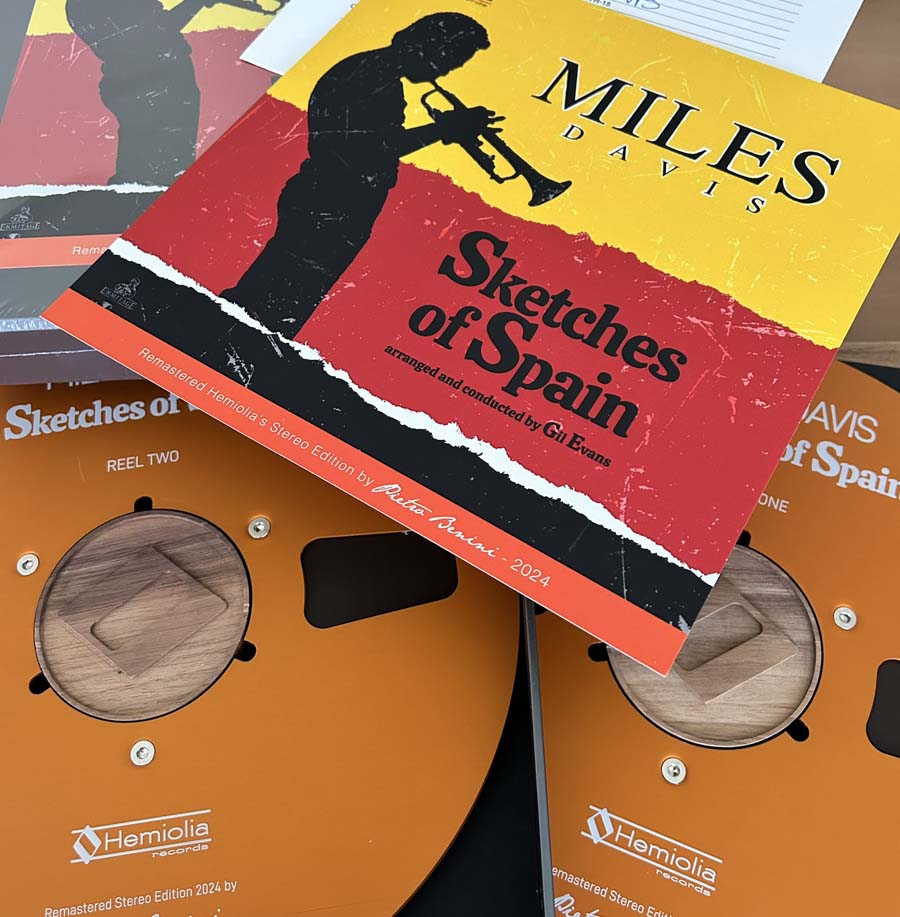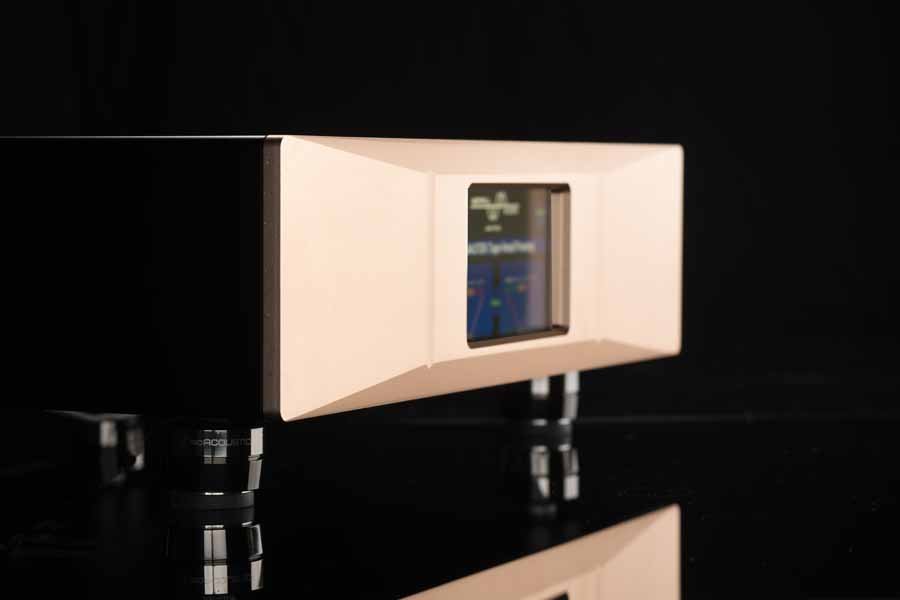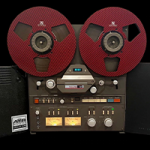SKETCHES OF SPAIN, HEMIOLIA MASTER TAPE
Alan McIntosh takes a listen to Sketches Of Spain, Miles Davis – Hemiolia Master Tape, 15ips

Hemiolia Records continue to release some of the most iconic Jazz albums around on open reel tape, including the giants Kind of Blue (Miles Davis) and Blue Train (John Coltrane), both of which I’ve reviewed previously for Hifi Pig- and their latest release Sketches of Spain (Miles Davis/Gil Evans) is the most recent, and eagerly anticipated, to arrive here at Mcintosh Towers. Originally recorded between 1959 and 1960 at the New York Columbia 30th Street Studio and released on Columbia Records, Sketches of Spain holds quite a special place in the history of Jazz and of Davis. Not only did it win a Grammy and enter the Rolling Stones list of 500 greatest albums of all time (no 358 for those interested) but its arrangement based on the classical adagio movement of Concierto de Aranjuez and an extract from the Spanish Ballet El amor brujo (Love, the sorcerer ) is a defining moment for Miles Davis and for a musical movement then known as the “Third Stream”.
Released a year after Kind of Blue, Sketches sees Davis work once more with the seminal jazz arranger and conductor Gil Evans, with whom he had previously collaborated with on Porgy and Bess. The album runs to five tracks, the first a mighty voyage of over 16 minutes, and the full programme totaling just over 41 minutes – the release here on 15ip ¼” tape runs across 2 reels of premium Recording the Masters (RTM) RM900 tape. This does leave a lot of dead tape on each reel but is the modus operandi of Hemiolia and does avoid “squeezing it” into one tape with only a “hair to spare” as it were. Interestingly this is a remastered Stereo mix by Hemiolias in house lead engineer Pietro Benini whose fingers have also worked magic on previous albums in the range.
As with previous Hemiolia releases you are in for a real treat aesthetically with a sturdy box, beautiful album graphics, liner notes, technical information, and a certificate of authenticity and limited edition “hype sticker”. The two reels themselves are in Hemiolis (and I think stunning) trademark orange with etched lettering and pre include leader tape (saves me a job adding it !). Each comes secured in the box on a beautiful wooden, H branded, spindle. Tapes, as you would expect are supplied tails out.
It appears on researching across the original vinyl liner notes (I have a lovely 1977 Columbia release PC8271) and the ubiquitous Wikipedia that there are two versions of the story of how Davis’ infatuation with Spanish music started – one suggests his wife Francis Davis suggested he join her to watch flamenco dancer Roberto Inglesias perform – he loved it and set to hunting out and consuming as many flamenco LPs as he could. The other omits this detail and purports it was a friend letting Davis hear a copy of Concierto de Aranjuez for Guitar and Orchestra (Joaquin Rodrigo), Davis became infatuated with the sound and this led to a call to arranger extraordinaire, Gil Evans, to discuss how they could bring that Flamenco sound to a US jazz audience. Evans recounts how he had to hand copy the music from a copy of Concierto de Aranjuez as there was no score, and while they had not intended to make a Spanish album per see, the more they listened to the folk music of the region and the music being played in Spanish clubs the more it became inevitable they were going there. He tells of how thrilled he was with the strength of the melody in Concierto – how beautiful it was – and it was here the album begins.
With a flurry of castanets Track 1, Concierto de Aranjuez (Adagio) (16’22”) opens and Davis leads out on Flugel horn in what feels like a sombre yet optimistic melody invoking images of the Spanish plains and the sun rising above a quaint little town. Following the original piece faithfully, later moving to his iconic trumpet Davis works hard to connect the piece across its more than 16 minutes run time. I say works hard, he felt he worked hard, all we hear is Davis’ seminal, effortless grace and style from beginning to end as he traverses what Evans biographer Stephaine Crease called “ a quasi-symphonic quasi-jazz wall of sound”. This gushing praise refers (for me) to the middle section where Evans extended and re-wrote the arrangement – Davis himself commented that he felt the adagio melody was so strong that “the softer you play it, the stronger it gets..” for the listener this is a joy as we are treated to a something that barely resembles jazz, more classical but with the mystique and latin emotion of Spain in spades. This isn’t a jazz standards “foot tapper” rather this is a track where I sit back and simply revel in the beauty of it – pair with a great full-bodied Rioja for the maximal effect! From that first clack of a castanet and throughout you are reminded why open reel is such a wonderful medium; the lack of compression or holding back of dynamics or space! As we enter the later sections, that optimism of playing rises to heraldic passion but can fall away to almost a whisper, as softer playing draws you in – all delivered in its rich glory.
It’s this “melding“ of Jazz, and Classical that composer Gunther Schuller dubbed the “Third Stream” . There are (as you’d imagine) several definitions of Third Stream, but typically (and contentiously) it means a jazz player or players performing with a symphony orchestra as long as the musicians are able to play and interpret Jazz music. It is not simply (as Schuler was at pains to point out) “Jazz with strings” or Jazz played on classical instruments and it’s not a fugue played by jazz players! Rhapsody in Blue by Goerge Gershwin is another notable example of “Third Stream” work.
Ruminations of the intricacies of Jazz and classical aside, we move onto track 2 of Sketches – Will o’ the Wisp (3’50”). Not (as many UK readers of certain age may think) a piece about a happy-go-lucky talking swamp gas who appeared on BBC television, but instead a song lifted from Manuel de Falla’s ballet – El Amor Brujo (Love, the Sorcerer, or Love, Enchanted – depending on the translation ). Cancion del Fuego Fatuo as it was originally titled is part of the storytelling of a nightly dance of a Gypsy woman and her dead husband’s spirit- a tale of lovers, infidelity and subterfuge, it’s everything you’d expect of a latin romance and is portrayed wonderfully by the players, led by Davis. A creeping, intrigue-laden, dramatic number bringing to life a dance with spirits, and an enchanted love – all handled deftly, sensitively, and with poise by the whole orchestra.
I’ve been remiss to this point in not mentioning the truly stellar cast of players involved in Sketches of Spain – beyond the incredible playing of Davis, and Evans conducting, we have (and in no particular order) the 26 (yes, twenty-six!) accompanying orchestra of musicians which includes greats such as Elvin Jones, Jimmy Cobb, Taft Jordan and Bernie Glow – and it’s great to see also Spanish players such as Jose Mangual Sr. on percussion – even the harpist Janet Putman. The range of instruments in the arrangements is staggering and to hear the interpretation of jazz at scale is a joy to hear – if challenging for the players, at least one (the trombonist Frank Rehak) noted with exasperation “This is a tough one !” The recording itself was a challenge, with so many levels to manage and harmonise and players to conduct (with the pedantic iron fist of Evans), physical positions of the orchestra that multiple takes, checks, reviews, and queries from Evans to the booth engineers were involved throughout. The result, however, is a masterpiece and a testament to Evans’ largely self-taught brilliance as conductor. This mixing in stereo really does allow the dimensionality of the arrangement to shine – a testament to the engineering skill of all involved.
Loading the second reel, we start with the traditional “Morning Song” The Pan Piper (5’56”) with its signature Penny Whistle portrayed by not 1 but 3 flutists in tight harmony (so tight Evans at one point had to check with the booth that the 3 were separated in recording). The original was from a local ethnic Andalusian recording and the penny whistle is reported to be from a local pig farmer drumming up trade – here it’s rewritten by Gil Evans with a traditional folk backbone. After Davis leads us off and the symphony rises softly to support, the almost militaristic drumming and march-like tempo of Saeta (5’03”) rolls in. A pause from the drums and Davis again takes an almost solo lead , with a melancholic lamentation and penitence traditionally heard on Good Friday during religions ceremonies and that spreads out, carrying our across the Spanish landscape and maintaining the tension building around it from the orchestra while drums keep us in place. As percussion and fanfare rise we feel like we are witnessing the battle and suffering of Christ on the cross! The flute work rises softly above the main body to mark time, drawing us ever closer.

It’s at these moments that we recognise the sheer skills of the players taking this “Third Stream” – this is an acute synergy of jazz and classical, albeit one that feels it lacks those jazz standard rhythms but is, nonetheless, a strident example of Davis’ skill on horn and the orchestra’s skill at playing and interpreting as “sidemen”. Davis’ skill and innate, effortless intimacy with phrasing and timbre led Nat Hentoff (the Jazz Review) to comment on the LP liner notes that “It is as if Miles had been born to Andalusian gypsies but, instead of picking up a guitar, had decided to make a trumpet the expression of his cante hondo (deep song)”.

We close with the pure Flamenco of Solea (12’15”). This is an emotional and evocative journey of loneliness in its delivery, with parallels to the blues in African-American contrasts. Davis’ solo starts, but soon percussion crashes and harp strums to accompany us on our journey seeking, but never finding solitude as the Spanish writer Ferran put it “Alas for me! The more is seek my solitude the less of it, I find. Whenever I look for it my shadow looks with me”. Once again that rolling snare and bass provides some swing to this dance and as we reach the midpoint the orchestra is rising to accompany, Davis dancing in his interpretation – almost recognising we are nearing the album climax and driving more drama and excitement for us – at times he is crying out loud with his horn, contrasting exceptionally the soft, breathy phrasing of earlier pieces. The broad dynamics of tape really do allow for such a swing in power and softness, at times the percussion is almost whispering but loses nothing of its musicality, while at others it’s crashing like waves hard against the horns of Davis – all with ease and a sonic quality unmatched in other mediums. Personally, Solea feels the closest to jazz in terms of rhythm and structure, where the previous tracks lean into the Symphonic and traditional.
A perfect balance overall I’d say.
Sketches of Spain is a truly exceptional album of work on any format – on tape, with its inherent wide dynamics, close proximity to the original and defacto analogue qualities it’s elevated once again and for any reel-to-reel enthusiast is a “must-buy” in my opinion.
A true joy and privilege to listen to.
Alan McIntosh
Sketches Of Spain (Miles Davis/Gil Evans) on 15ips CCIR equalization ¼” 2 Track Tape (NAB available on request) is available from Hemiolia Records at RRP €779 + Taxes & Shipping .
Track listing
Reel one:
1 – Concierto De Aranjuez (Adagio) – 16’22”
2 -Will O’ The Wisp (From “El Amor Brujo”) – 03’50”
Reel two:
1 – The Pan Piper – – 05’56”
2 – Saeta – 05’03’’
3 – Solea – 12’15”
Total length: 41’26”
Associated review equipment – Tascam 32, Hegel 390 Amplifier, Blumenhofer Tempesta 17 Speakers, Missing Link Alaqeia Interconnects, Tellurium Q Black II speaker cable, power distribution and cabling by Titan Audio, Room treatment by GIK Acoustics, racking by Quadraspire.
READ MORE REEL-2-REEL AND ALBUM REVIEWS






















































































































































































